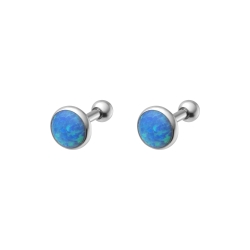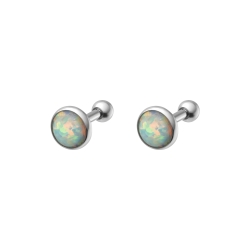Opal - knowledge base, jewelry
Properties of opal, physiological effects, zodiac signs and opal jewelry.








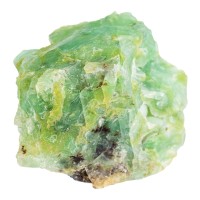
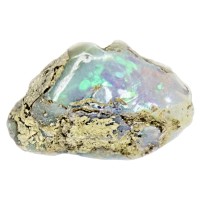
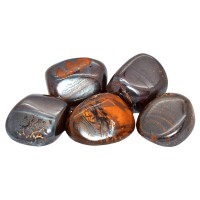
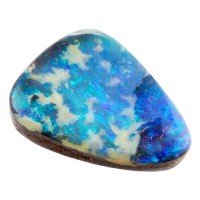
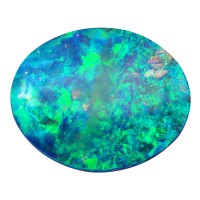
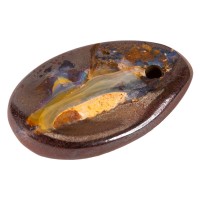
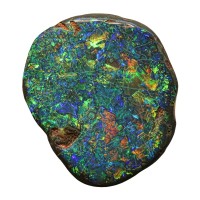
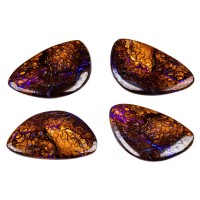
Opal is a hydrated amorphous form of silica.
It is formed by leaching rocks containing silicate minerals, silica dissolves from the rocks and accumulates in cavities, fissures, dries and hardens. It is formed mainly by hot springs and geysers and is found in the cracks of weathered, eruptive rocks, clustered, kidney-shaped or stalactite masses. The light, transparency, color and appearance of the opal are very varied, but always perfectly amorphous, without any traces of crystallization, with a shell fracture and a hardness less than quartz. The most notable version is the noble.
Chemical and physical properties of opal:
Formula:
SiO2*nH2O
Crystal system:
trigonal
Category:
chalcedony variety
Color:
varied, coloured by mineral inclusions
Streak:
white
Transparency:
glass, resin or wax gloss
Cleavage:
none
Fracture:
conchoidal, splintery
Mohs scale hardeness:
5,5 – 6,5
Specific gravity:
2,09 g/cm³
Major metaphysical healing properties attributed to opal:
It improves circulation, strengthens the airways, reduces blood clots, helps with stomach upset, improves bone growth, helps with varicose veins, stress reliever, helps with depression and anxiety, improves communication, creativity.
Zodiacs associated with opal gemstones:
Opal is the gemstone of the zodiac sign of Libra and Scorpio.
Click here to read about the general characteristics of horoscopes!
A part of our opal jewelry offer. Click on the images for more details!
For more jewelry please click here!
The most beautiful Hungarian opals are in the Natural History Museum in Vienna.
Among other things, a piece weighing 594 g, estimated to be worth millions of gold crowns, was found. It is said to have been a gift to Maria Theresa from a flint merchant named Haupt.
The characteristic of opals is their dull silky shine,
caused by the refraction of microscopic water droplets trapped in the solidified silica gel material. When heated or impacted, the opal loses some or all of its water content, becomes brittle and loses its valuable luminosity. The mineral is also sensitive to alkalis and acids.
There are two main groups of precious opal:
The light and pure white and the dark, grey or bluish black noble opal. Very black stones are very rare. The former are mainly dominated by red and green, while the darker toned opals are also blue.
Varieties of precious opal:
- banded opal luminous,
- opal shining in round patches,
- angular patches of shiny opal – harlequin- opal,
- opal shining in yellow light,
- opal forming thinner-thicker veins in the bedrock,
- a yellowish or reddish glowing fire opal.
Until the last century, the most beautiful and valuable opals in the world were found in Hungary.
These deposits have since long since been exhausted, but the opal mines in Australia have been discovered and are now considered by the world to be the most significant source of the gemstone. Precious opals have been found in Guatemala, Honduras, Mexico, the United States, Arizona and Japan. However, the most beautiful stones are found in Brasil.
Precious opal is one of the few gemstones that has not yet been artificially produced in a laboratory,
so no synthetic version exists yet. The characteristic opalescent colour effect was not produced within the stone. Until the 1960s, it was not known what causes the colour of opals. Electron microscopic analysis of precious opal has identified the micron-sized minerals that cause opalescence.
Other varieties of opal:
- milky quartz opal,
- lime-opal,
- brown- opal,
- green- semi-opaque,
- wood opal.
There are also opal semi-finished products:
- white hydrophane,
- cacholong,
- jaspopal,
- cryolite,
- geyserite.
Precious opal occurs as a coating in the cavities and cracks of sandstone.
The occurrence of precious opal is not linked to a particular mineral or rock. Mostly found in volcanic rocks or in sediments, their formation requires the right chemical and geological conditions. All the sites agree that the noble opal is present as fine coatings, veins on the surface of the bedrock, in cavities or cracks.
The mining of opal:
If the miner finds a rocky outcrop or vein covered with precious opal, he carefully extracts the valuable mineral along with the mother rock. From the extracted rough stones, the opal is carefully removed in a workshop by specialists. The aim is to extract the largest possible continuous piece.






